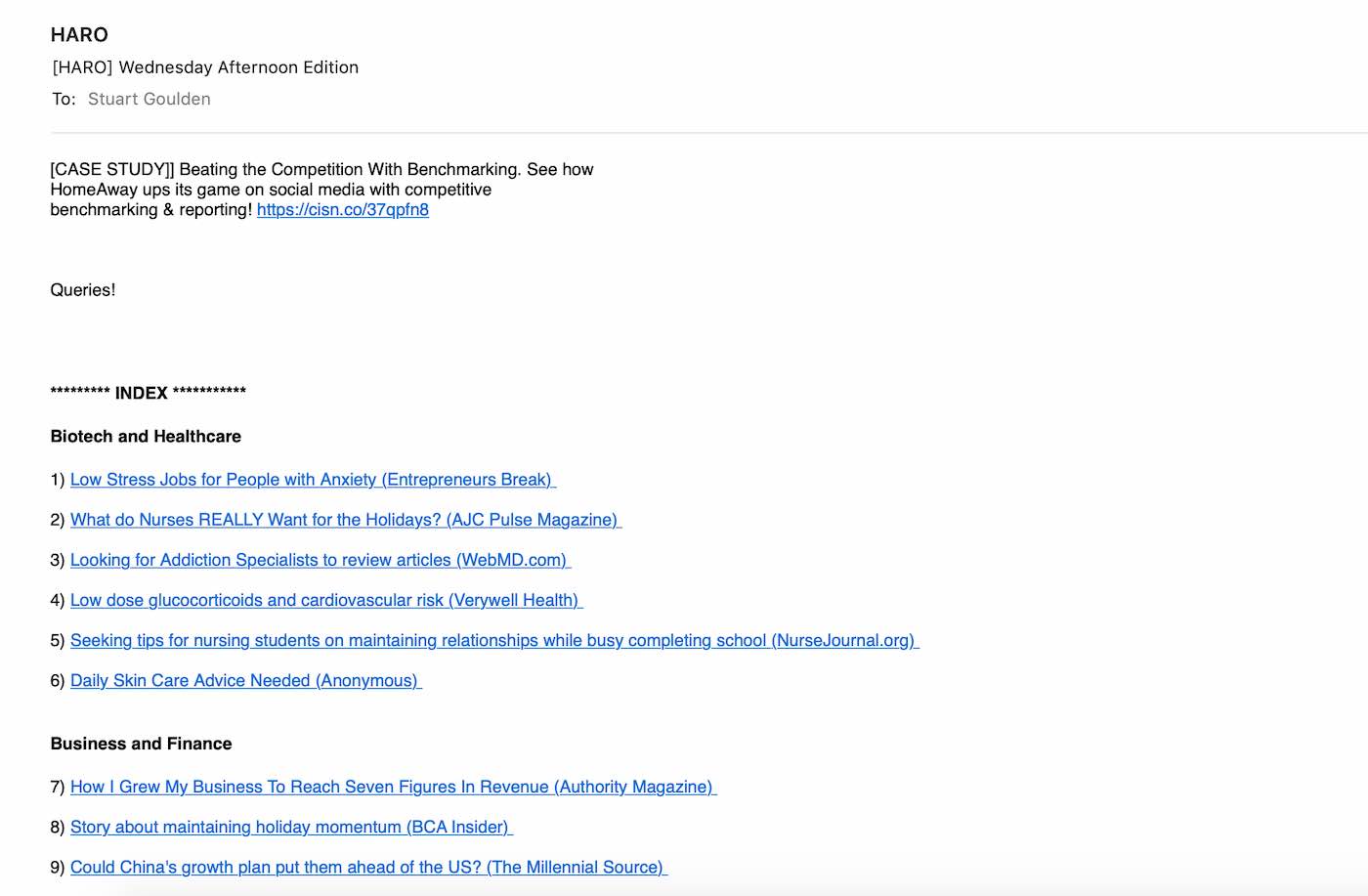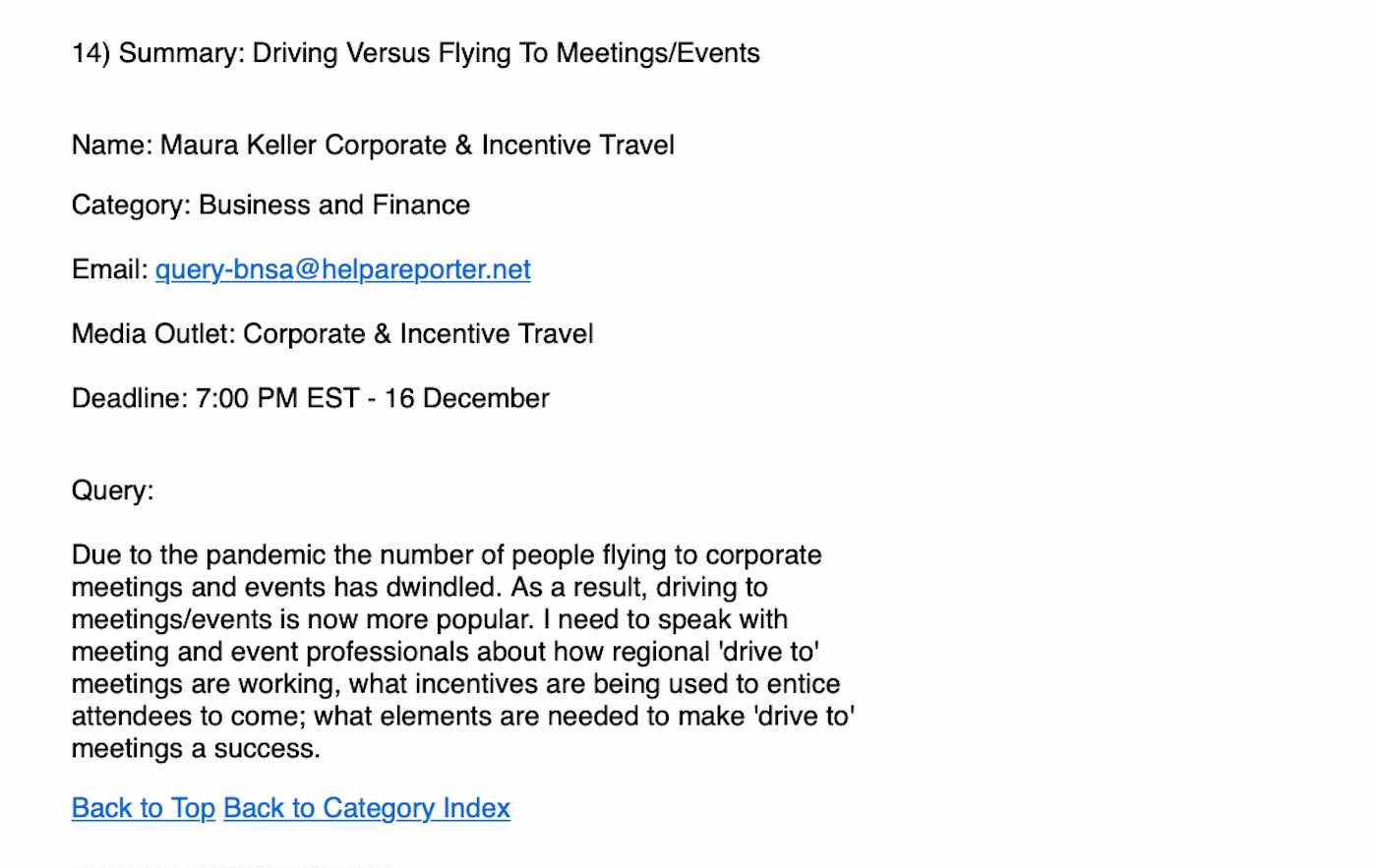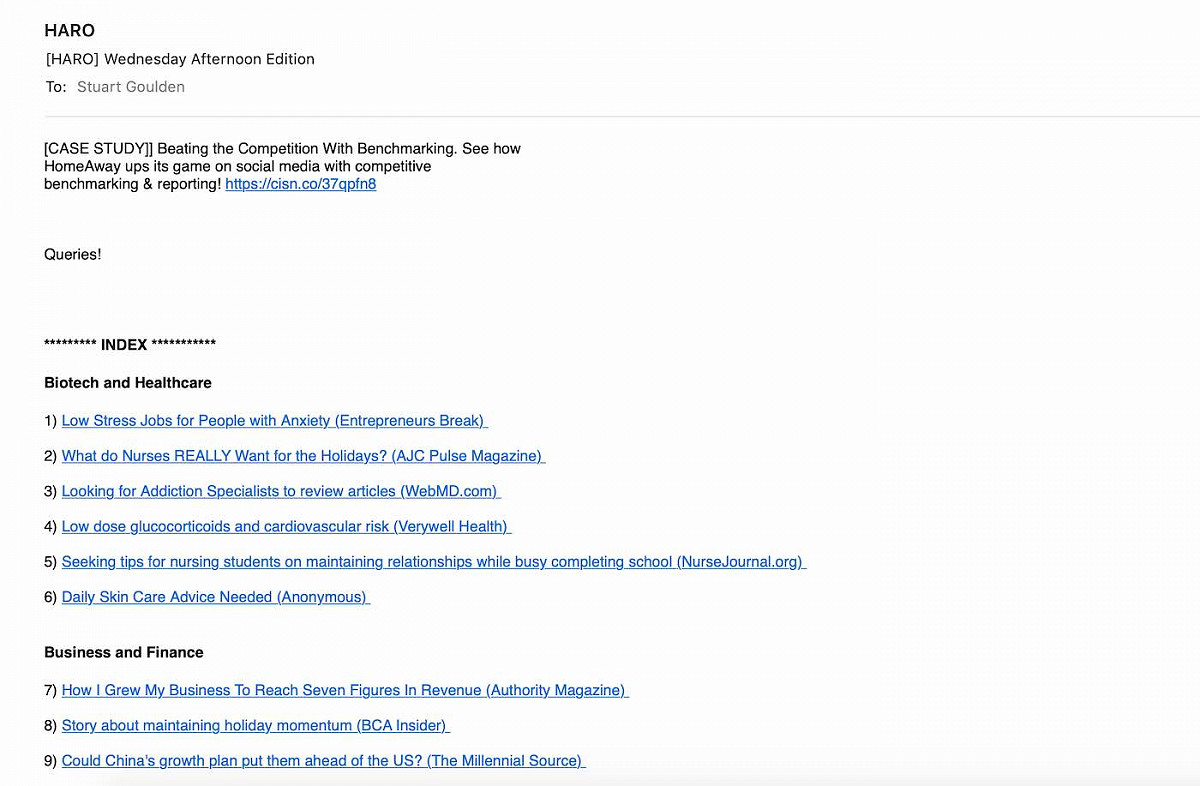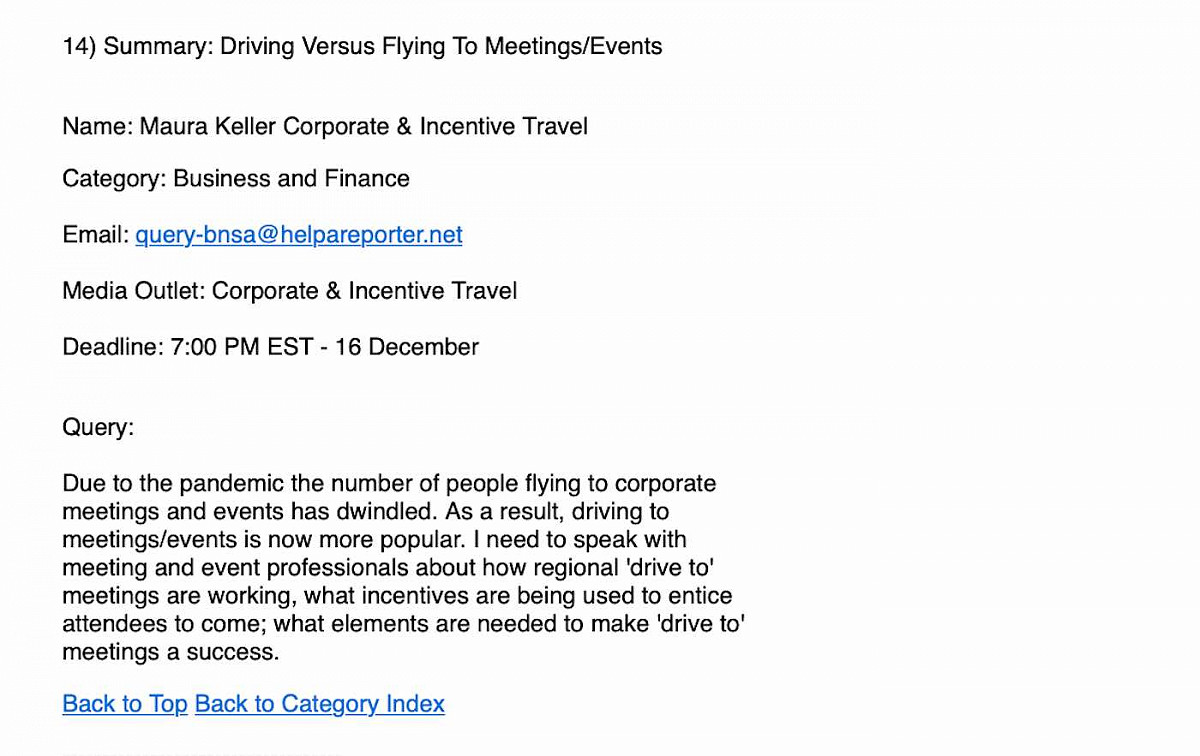Help a Reporter Out Review: Free PR opportunities, in your inbox
Surges is 100% independent, but some links may earn us an affiliate commission. Learn more.
TL;DR
Help a Reporter Out (HARO) sends 75+ opportunities for free media exposure direct to your inbox every day. The email is full of stories journalists are working on but missing an expert source, aka you. HARO is used by top news outlets such as Forbes, Reuters, The New York Times, CNN and ABC, as well as countless company blogs, so if you’re wondering how your competitor is picking up all their hot coverage this free tool is probably their secret weapon.
Help a Reporter Out Pros
- Free PR opportunities
- Used by top publications
- Has helped many businesses
- Text alerts (premium)
Help a Reporter Out Cons
- Predominantly US focused
- Hard to get noticed
The Story
What is Help a Reporter Out?
HARO subscribers get three emails a day full of news stories about their sector need of a source. It’s made for startups wanting to gain traction without the awkward, soul-destroying pitching to journalists associated with traditional PR.
However, with a mailing list now 800,000 sources strong, competition for free exposure is fierce. Read on to learn how to get the attention of journalists on HARO, how it compares to HARO alternatives and whether it’s worth the cost of getting a paid subscription.

Meet the Maker:
Peter Shankman
HARO hasn’t changed much since its first email in 2008. Setup by PR guru Peter Shankman, it started life as a Facebook page where journalists posted daily PR opportunities to meet their demanding deadlines. That community grew quickly so Peter switched to a simply daily email to make it more manageable – a trusty format its stuck with since. Fast forward 10 years, via an acquisition and subsequent merger, HARO is now owned by PR multinational Cision with 55,000 journalists and bloggers signed up with the free service.
The Product
How we tested Help a Reporter Out for this review
It’s been a while since I last subscribed to HARO. Having gotten a lot of success with #JournoRequest I had given the free PR email a chance back in 2014-15, but with very little success.
However, I’m still a sucker for free publicity so decided to give it another go on the back of trying out The Press Index and Press Notify. Despite having the same end goal, all three have completely different models.
Getting started with Help a Reporter Out
Most HARO users don’t pay for the privilege, so with no bio and background info the sign-up process is extremely quick.
On doing so you’re automatically subscribed to the ‘Master HARO’ email list – a catch-all for that day’s featured requests from journalists. You can choose to keep this and/or dive into more focused categories like Business and Finance, Biotech and Healthcare, Education, Energy and Green Tech, Entertainment and Media, Travel and so on. Many of these were ‘coming soon’ at the time of this review in December 2020, but what you’re really do is opting in for when numbers are up and the category warrants its own daily email.
And that’s it! The following day and every day thereafter you’ll receive a daily HARO email and are free to respond to any requests that seem relevant.
Help a Reporter Out features you’ll love
-
📧 Reporter email - sent three-times daily
The HARO newsletter is delivered Monday-Friday, as a morning and afternoon edition.

Every newsletter contains 75+ queries from reporters looking for businesses and products to feature in the stories they’re writing. The categories are extremely broad, so the opportunities are unlikely to be laser-focused to your precise situation. Hunting down leads is easy but takes some imagination.

You’ll see a summary of the request (e.g. ‘How has 2020 changed the way in which HR operates?’), the deadline the journalist is working to and occasionally the publication. Journalists tend to opt for their name and email address to be masked, with recipients instead replying via the anonymous email generated by HARO.
This system stops reporters from getting spammed with PR emails, which the typical journalist already receives far too many of.
-
🗣️ Sending your reply - act fast, add value
In theory, HARO matches journalist queries with eager industry experts. The reality is that HARO is a free for all.
Journalists receive many more replies than they need so success rate is low, generally under 10%. Especially if you’re not based in the US.
You can increase your odds of standing out and being published by responding quickly and staying on topic. Journalists will ignore salespitches outright plus off-topic pitches are against HARO terms. It’s a three strikes and you’re out policy for any breaches of this golden rule. Authentic expertise or experience only.
Other tips include keeping your pitch concise and making sure you don’t forget to include a short bio and your contact information too.
-
⏰ Go pro – get a heads-up on enquiries
Monthly subscriptions cost $19 and upwards but comes with some great perks:
- Get alerts: as soon as a query is posted, allowing you to act fast, if not the fastest
- Filter your alerts: Hone in on the keywords/opportunities that matter most
- Complete a profile: Automatically add a bio to your responses
A paid subscription to HARO is not absolutely necessary but unless your schedule and workload allows you to act as your own PR agency, this is the next best thing.
Things to consider
-
My own experience
I’ve been a member for HARO for a number of years, dipping in and out of the daily emails. Despite sending 30+ replies I’ve only received a couple of responses back from journalists. That’s not a good return!
In contrast, #journorequest on Twitter has got me and my businesses in the likes of the Guardian, The Times and dozens of magazines. All for free.
I think the main reason behind this is being predominantly based in the UK and the different time zones that slowed down my response time. Not great for journalists on a tight deadline. The competition on HARO is tough, so you need to be available and relevant to really impress.
Help a Reporter Out Pricing & Offers
from Free
HARO don’t make percentage of its users on the free plan public but I suspect it’s the overwhelming majority. The platform is always free for journalists.
If you’ve built a routine around checking the emails the moment they come out and can respond quickly and with a readymade bio, I’d certainly advise starting with the free version.
Upgrading costs $19 a month a gets you the ability to filter for keywords associated with your niche and instant access to requests so you can jump the queue. I’ll be checking out a paid version in the future review so keep checking back to see how I got on.
Help a Reporter Out Alternatives
The world of public relations is a very different place compared to a decade ago. HARO has arguably played a leading role in cutting out the middleman and making securing free news coverage more achievable. However, it’s not the only digital PR service out there…
HARO alternatives range from hiring a PR agency, with the associated costs, or turning to other digital PR tools include the #JournoRequest hashtag on Twitter, Press Notify and The Press Index.
The JournoRequest hashtag can be a goldmine of promising opportunities with journalists desperate to meet a pressing deadline. If you’ve capacity to respond to queries in a timely matter, this free service is a must.
On the flip side, The Press Index is a paid directory for CEOs available for interview. Journalists log in and do are the leg work, so if you’re willing to pay the subscription charge you can sit back and wait for the opportunities come to you.
Press Notify is different setup altogether, helping you to pitch multiple news outlets at once. Much better when you have something to launch.
Help a Reporter Out Support 👍 or 👎
The email-based service is so simple there’s unlikely to be any service queries. However, with journalists snowed under an avalanche of responses the platform can leave you feeling a little low if none of your emails are getting answered. A simple read receipt or validation of your response, such as a thumbs up from the journalist, would be a good way to keep entrepreneurs engaged and active on the platform.
The Verdict
Surges score
75%Crave free media mentions but have no time for manual outreach? Help A Reporter Out has also helped many a business out.
The three-daily newsletters provide a constant feed of journalist requests but the sheer volume of sources (800,000+) make it extremely difficult to have your pitch seen. That’s not to say it’s impossible. Users applying a tried-and-tested formula to replying and who have their finger on the trigger will improve their odds of success and can achieve strong organic growth via the service.
A premium account is a shortcut to success, with advanced keyword filters and text alerts, helping you to respond first and better your chances of being picked for publication. At $19 per month, it’s great value and can pay for itself many times over with a single feature in a major news outlet.
I recommend trying out the free version of HARO for a few weeks. Suss out how relevant the enquiries are to your sector and see if you get any journalists nibble at your replies. Only then is it worth investing more time in.





